Left- and right-hand traffic
Left-hand traffic (LHT) and right-hand traffic (RHT) are the practices, in bidirectional traffic, of keeping to the left side or to the right side of the road, respectively. They are fundamental to traffic flow, and are sometimes referred to as the rule of the road.[1]

RHT is used in 165 countries and territories, with the remaining 75 countries and territories using LHT.[2] Countries that use LHT account for about a sixth of the world's land area, with about a third of its population and a quarter of its roads.[3] In 1919, 104 of the world's territories were LHT and an equal number were RHT. Between 1919 and 1986, 34 of the LHT territories switched to RHT.[4]
Many LHT countries were formerly part of the British Empire, although many were not, such as Sweden (which is now RHT), Japan, Thailand, Indonesia, Nepal and Suriname, among others. Conversely, many RHT countries were part of the French colonial empire.
In LHT traffic keeps left, and cars have the steering wheel on the right (RHD – right hand drive), putting the driver on the side closest to the centre of the road. Roundabouts circulate clockwise. RHT is the opposite of this: traffic keeps right, the driver sits on the left side of the car (LHD), and roundabouts circulate anticlockwise.
In most countries rail traffic follows the handedness of the roads, although many of the countries that switched road traffic from LHT to RHT did not switch their trains. Boat traffic on rivers is effectively RHT. Boats are traditionally piloted from the starboard side to facilitate priority to the right.
History
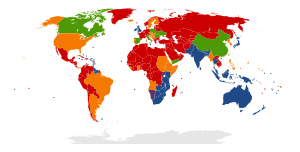
Historically, many places kept left, while many others kept right, often within the same country. There are many myths which attempt to explain why one or the other is preferred.[5] About 90 percent of people are right handed,[6] and many explanations reference this. Horses are traditionally mounted from the left, and led from the left, with the reins in the right hand. So people walking horses might use RHT, to keep the animals separated. Also referenced is the need for pedestrians to keep their swords in the right hand and pass on the left as in LHT, for self-defence. It has been suggested that wagon-drivers whipped their horses with their right hand, and thus sat on the left hand side of the wagon, as in RHT. It has been written that in the year 1300, Pope Boniface VIII directed pilgrims to keep left, however it has also been written that he directed them to keep to the right, and there is no documented evidence to back either claim.[5]
Europe
One of the first references in England to requiring traffic direction was an order by the London Court of Aldermen in 1669, requiring a man to be posted on London Bridge to ensure that "all cartes going to keep on the one side and all cartes coming to keep on the other side".[7] It later was legislated as the London Bridge Act 1765 (29 Geo. II c. 40), which required that "all carriages passing over the said bridge from London shall go on the east side thereof" – those going south to remain on the east, ie the left-hand side by direction of travel.[8] This may represent the first statutory requirement for LHT.[9]
A frequently-heard story is that Napoleon changed the custom from LHT to RHT in France and the countries he conquered after the French Revolution. Scholars who have looked for documentary evidence of this story have found none, and it should be assumed a myth unless contemporary sources surface.[4] In 1827, long after Napoleon's reign, Edward Planta wrote that, in Paris, "The coachmen have no established rule by which they drive on the right or left of the road, but they cross and jostle one another without ceremony."[10]
Rotterdam was LHT until 1917,[11] although the rest of the Netherlands was RHT.
Russia completely switched to RHT in the last days of the Tsars in February 1917.
After the Austro-Hungarian Empire broke up, the resulting countries gradually changed to RHT. In Austria, Vorarlberg switched in 1921, North Tyrol in 1930, Carinthia and East Tyrol in 1935, and the rest of the country in 1938.[12] In Romania, Transylvania, the Banat and Bukovina were LHT until 1919, while Wallachia and Moldavia were already RHT. Partitions of Poland belonging to the German Empire and the Russian Empire were RHT, while the former Austrian Partition changed in the 1920s.[13] Croatia-Slavonia switched on joining the Kingdom of Yugoslavia in 1918, although Istria and Dalmatia were already RHT.[14] Nazi Germany introduced the switch in Czechoslovakia and Slovakia in 1938–1939.[15][16] West Ukraine was LHT, but the rest of Ukraine, having been part of the Russian Empire, was RHT.
In Italy it had been decreed in 1901 that each province define its own traffic code, including the handedness of traffic,[17] and the 1903 Baedeker guide reported that the rule of the road varied by region.[5] For example, in Northern Italy, the provinces of Brescia, Como, Vicenza, and Ravenna were RHT while nearby provinces of Lecco, Verona, and Varese were LHT,[17] as were the cities Milan, Turin, and Florence.[5] In 1915, allied forces of World War I imposed LHT in areas of military operation, but this was revoked in 1918. Rome was reported by Goethe as LHT in the 1780s. Naples was also LHT although surrounding areas were often RHT. In cities LHT was considered safer since pedestrians, accustomed to keeping right, could better see oncoming vehicular traffic.[17] Finally, in 1923 Italian Duce Benito Mussolini decreed that all LHT areas would gradually transition to RHT.[17] In spite of this, some Italian heavy commercial vehicles were right-hand drive until the traffic code was changed in 1959.
Portugal switched to RHT in 1928.[1]
Finland, formerly part of LHT Sweden, switched to RHT in 1858 as the Grand Duchy of Finland by Russian decree.[18]

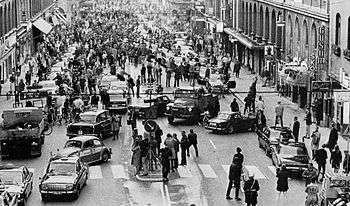
Sweden switched to RHT in 1967, having been LHT from about 1734[19] despite having land borders with RHT countries, and approximately 90% of cars being left-hand drive (LHD).[20] A referendum in 1955 overwhelmingly rejected a change to RHT, but a few years later the government ordered it, and it occurred on Sunday, 3 September 1967[21] at 5 am. The accident rate then dropped sharply,[22] but soon rose to near its original level.[23] The day was known as Högertrafikomläggningen, or Dagen H for short.
When Iceland switched to RHT the following year, it was known as Hægri dagurinn or H-dagurinn ("The H-Day").[24] Most passenger cars in Iceland were already LHD.
The United Kingdom is LHT, but two of its overseas territories, Gibraltar and the British Indian Ocean Territory, are RHT. In the late 1960s, the British Department for Transport considered switching to RHT, but declared it unsafe and too costly for such a built-up nation.[25] Road building standards, for motorways in particular, allow asymmetrically designed road junctions, where merge and diverge lanes differ in length.[26]
Today, four countries in Europe continue to use LHT; they are all island nations: the United Kingdom, Republic of Ireland (formerly part of the United Kingdom) and Cyprus and Malta (both former British colonies).
Africa


LHT was introduced in British West Africa. All of the countries formerly part of this colony border with former French RHT jurisdictions and have switched to RHT since decolonization. These include Ghana, Gambia,[27] Sierra Leone, and Nigeria. Britain introduced LHT to the East Africa Protectorate (now Kenya, Tanzania and Uganda), Rhodesia, and the Cape Colony (now Zambia, Zimbabwe and South Africa). All of these have remained LHT. Sudan, formerly part of Anglo-Egyptian Sudan switched to RHT in 1973, as most of its neighbours were RHT countries, with the exception of Uganda and Kenya, but since the independence of South Sudan in 2011, all of its neighbours drive on the right. Despite it sharing land borders with two LHT countries, South Sudan has retained RHT.[28] The Portuguese Empire, then LHT, introduced LHT to Portuguese Mozambique and Portuguese Angola. Although Portugal itself switched to RHT in 1928, Mozambique remained LHT as they have land borders with former British colonies. Other former Portuguese colonies in Africa including Portuguese Angola, Guinea-Bissau, São Tomé and Príncipe, and Cape Verde switched to RHT in 1928.
France introduced RHT in French West Africa and the Maghreb, where it is still used. Countries in these areas include Mali, Mauritania, Ivory Coast, Burkina Faso, Benin, Niger, Morocco, Algeria, and Tunisia. Other French former colonies that are RHT include Cameroon, Central African Republic, Chad, Djibouti, Gabon, and the Republic of the Congo.
Rwanda and Burundi are RHT but are considering switching to LHT (see "Potential future shifts" section below).
North America
In the late 1700s, traffic in the United States was RHT based on teamsters' use of large freight wagons pulled by several pairs of horses. The wagons had no driver's seat, so the (typically right-handed) postilion held his whip in his right hand and thus sat on the left rear horse. Seated on the left, the driver preferred that other wagons pass him on the left so that he could be sure to keep clear of the wheels of oncoming wagons.[29] The first keep-right law for driving in the United States was passed in 1792 and applied to the Philadelphia and Lancaster Turnpike.[30] New York formalized RHT in 1804, New Jersey in 1813, and Massachusetts in 1821.[31] Today the United States is RHT except the United States Virgin Islands,[32] which is LHT like many neighbouring islands.
Some special-purpose vehicles in the United States, including certain postal service trucks, garbage trucks, and parking enforcement vehicles, are built with the driver's seat on the right for safer and easier access to the curb. A common example is the Grumman LLV used nationwide by the United States Postal Service.
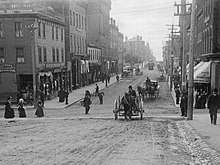
As former French colonies, the provinces of Quebec and Ontario were always RHT.[33] The province of British Columbia changed to RHT in stages from 1920 to 1923.[34][35] New Brunswick, Nova Scotia, and Prince Edward Island, changed to RHT in 1922, 1923, and 1924 respectively.[36] Newfoundland, then a British colony,[37] changed to RHT in 1947, two years before joining Canada.[38]
In the West Indies, colonies and territories drive on the same side as their parent countries, except for the United States Virgin Islands. Many of the island nations are former British colonies and drive on the left, including Jamaica, Antigua and Barbuda, Barbados, Dominica, Grenada, Saint Kitts and Nevis, Saint Lucia, Saint Vincent and the Grenadines, Trinidad and Tobago, and The Bahamas. However, most vehicles in The Bahamas,[39] British Virgin Islands,[40] Cayman Islands,[41] Turks and Caicos Islands[42] and United States Virgin Islands are left hand drive.[40]
Asia
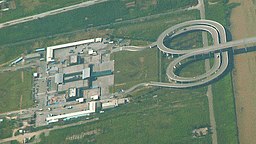
LHT was introduced by the British in British India (now India, Pakistan, Myanmar, and Bangladesh), British Malaya and British Borneo (now Malaysia, Brunei and Singapore), and British Hong Kong. All are still LHT except Myanmar, which switched to RHT in 1970,[43] although much of its infrastructure is still geared to LHT. Most cars are used RHD vehicles imported from Japan.[44] Afghanistan was LHT until the 1950s, in line with neighbouring British India and later Pakistan.[45]
LHT was introduced by the Portuguese Empire in Portuguese Macau (now Macau) and Portuguese Timor (now East Timor). Both places are still LHT, despite Macau now being part of RHT China, requiring a right-to-left switching interchange at the Lotus Bridge which connects the two. East Timor shares the island of Timor with Indonesia, which is also LHT, although the former (then Portuguese Timor) switched to RHT along with Portugal in 1928[1] before changing back to LHT in 1976 during the Indonesian occupation of East Timor.
Mainland China is RHT except the Special Administrative Regions of Hong Kong and Macau. LHT was uniform in the 1930s, then the northern provinces were RHT. Nationalist China adopted RHT in 1946. This convention was preserved when the CCP took the mainland and the KMT retreated to Taiwan.
In Taiwan, it uses RHT. During Japanese rule of Taiwan, they formerly used LHT until its liberation in 1945 when it switched to RHT by the Chinese government in 1946, which remains in place today.
Both North Korea and South Korea switched to RHT in 1945 after liberation from Japanese colonial power.
The Philippines was mostly LHT during its Spanish[46] and American colonial periods,[47][48] as well as during the Commonwealth era.[49] During the Japanese occupation, the Philippines remained LHT,[50] also because LHT had been required by the Japanese;[51] but during the Battle of Manila, the liberating American forces drove their tanks to the right for easier facilitation of movement. RHT was formalised in 1945.[52]
Japan was never part of the British Empire, but its traffic also drives on the left. Although the origin of this habit goes back to the Edo period (1603–1868), it was not until 1872 that this unwritten rule became more or less official. That was the year when Japan’s first railway was introduced, built with technical aid from the British. Gradually, a massive network of railways and tram tracks was built, with all trains and trams being driven on the left-hand side. However, it took another half century until 1924, in which left-hand traffic was clearly written in law. Post-World War II Okinawa was ruled by the United States Civil Administration of the Ryukyu Islands and was RHT. It was returned to Japan in 1972 but did not convert back to LHT until 1978.[53] The conversion operation was known as 730 (Nana-San-Maru, which refers to the date of the changeover, 30 July). Okinawa is one of few places to have changed from RHT to LHT in the late 1900s.
Vietnam became RHT as part of French Indochina, as did Laos and Cambodia. In Cambodia, RHD cars, many of which were smuggled from Thailand, were banned from 2001, even though they accounted for 80% of vehicles in the country.[54]
Oceania
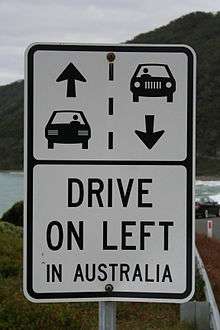
Many former British colonies in the region have always been LHT, including Australia, New Zealand, Fiji, Kiribati, Solomon Islands, Tonga, and Tuvalu, as well as nations which were previously administered by Australia, those being Nauru and Papua New Guinea.
Samoa, a former German colony, had been RHT for more than a century, but switched to LHT in 2009,[55] This made it the first territory in almost 30 years to change sides.[56] The move was legislated in 2008 to allow Samoans to use cheaper right-hand drive (RHD) vehicles—which are better suited for left-hand traffic—imported from Australia, New Zealand or Japan, and to harmonise with other South Pacific nations. A political party, The People's Party, was formed by the group People Against Switching Sides (PASS) to try to protest against the change, with the latter launching a legal challenge,[57] and in April 2008 an estimated 18,000 people attended demonstrations against it.[58] The motor industry was also opposed, as 14,000 of Samoa's 18,000 vehicles were designed for RHT and the government refused to meet the cost of conversion.[56] After months of preparation, the switch from right to left happened in an atmosphere of national celebration. There were no reported incidents.[3] At 05:50 local time, Monday 7 September, a radio announcement halted traffic, and an announcement at 6:00 ordered traffic to switch to LHT.[55] The change coincided with more restrictive enforcement of speeding and seat-belt laws.[59] That day and the following day were declared public holidays, to reduce traffic.[60] The change included a three-day ban on alcohol sales, while police mounted dozens of checkpoints, warning drivers to drive slowly.[3]
South America
Brazil was a colony of Portugal until the early 19th century and during this century and the early 20th century had mixed rules, with some regions still on LHT, switching these remaining regions to RHT in 1928, the same year Portugal switched sides.[61] Other Central and South American countries that later switched from LHT to RHT include Argentina, Chile, Panama,[62] Paraguay,[63] and Uruguay.
Suriname, along with neighbouring Guyana, are the only two remaining LHT countries in South America.[64]
Potential future shifts
Rwanda and Burundi, former Belgian colonies in Central Africa, are RHT but are considering switching to LHT[65][66] like neighbouring members of the East African Community (EAC).[67] A survey in 2009 found that 54% of Rwandans favoured the switch. Reasons cited were the perceived lower costs of RHD vehicles, easier maintenance and the political benefit of harmonious traffic regulations with other EAC countries. The survey indicated that RHD cars were 16% to 49% cheaper than their LHD counterparts.[68] In 2014, an internal report by consultants to the Ministry of Infrastructure recommended a switch to LHT.[69] In 2015, the ban on RHD vehicles was lifted; RHD trucks from neighbouring countries cost $1000 less than LHD models imported from Europe.[70][71]
Changing sides at borders

Although many LHT jurisdictions are on islands, there are cases where vehicles may be driven from LHT across a border into a RHT area. Such borders are mostly located in Africa and southern Asia. The Vienna Convention on Road Traffic regulates the use of foreign registered vehicles in the 78 countries that have ratified it.
LHT Thailand has three RHT neighbours: Cambodia, Laos, and Myanmar. Most of its borders use a simple traffic light to do the switch, but there are also interchanges which enable the switch while keeping up a continuous flow of traffic.[72]
There are four road border crossing points between Hong Kong and Mainland China. In 2006, the daily average number of vehicle trips recorded at Lok Ma Chau was 31,100.[73] The next largest is Man Kam To, where there is no changeover system and the border roads on the mainland side Wenjindu intersect as one-way streets with a main road.
The Takutu River Bridge (which links LHT Guyana and RHT Brazil[74]) is the only border in the Americas where traffic changes sides.
Although the United Kingdom is separated from Continental Europe by the English Channel, the level of cross-Channel traffic is very high; the Channel Tunnel alone carries 3.5 million vehicles per year by the Eurotunnel Shuttle between the UK and France.
Road vehicle configurations
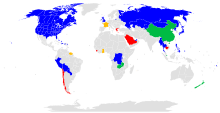
Steering wheel position
In RHT jurisdictions, vehicles are configured with LHD (Left Hand Drive[75]), with the steering wheel on the left side. In LHT jurisdictions, the reverse is true. The driver's side, the side closest to the centre of the road, is sometimes called the offside, while the passenger side, the side closest to the side of the road, is sometimes called the nearside.[76]
Most windscreen wipers are designed to clear the driver's side better and have a longer blade on the driver's side[77] and wipe up from the passenger side to the driver's side. Thus on LHD configurations, they wipe up from right to left, viewed from inside the vehicle, and do the opposite on RHD (Right Hand Drive) vehicles.
Regardless of steering wheel position, the turn signal lever is on the side closer to the driver's door, except in some European RHD vehicles where it is on the opposite side.
Historically there was less consistency in the relationship of the position of the driver to the handedness of traffic. Most American cars produced before 1910 were RHD.[30] In 1908 Henry Ford standardised the Model T as LHD in RHT America,[30] arguing that with RHD and RHT, the passenger was obliged to "get out on the street side and walk around the car" and that with steering from the left, the driver "is able to see even the wheels of the other car and easily avoids danger."[78] By 1915 other manufacturers followed Ford's lead, due to the popularity of the Model T.[30]
In specialised cases, the driver will sit on the nearside, or curbside. Examples include:
- Where the driver needs a good view of the nearside, e.g. street sweepers, or vehicles driven along unstable road edges.[79]
- Where it is more convenient for the driver to be on the nearside, e.g. delivery vehicles. The Grumman LLV postal delivery truck is widely used with RHD configurations in RHT North America. Some Unimogs are designed to switch between LHD and RHD to permit operators to work on the more convenient side of the truck.
Generally, the convention is to mount a motorcycle on the left,[80] and kickstands are usually on the left[81] which makes it more convenient to mount on the safer kerbside[81] as is the case in LHT. Some jurisdictions prohibit fitting a sidecar to a motorcycle's offside.[82][83]
Headlamps and other lighting equipment

Most low-beam headlamps produce an asymmetrical light suitable for use on only one side of the road. Low beam headlamps in LHT jurisdictions throw most of their light forward-leftward; those for RHT throw most of their light forward-rightward, thus illuminating obstacles and road signs while minimising glare for oncoming traffic.
In Europe, headlamps approved for use on one side of the road must be adaptable to produce adequate illumination with controlled glare for temporarily driving on the other side of the road,[84]:p.13 ¶5.8. This may be achieved by affixing masking strips or prismatic lenses to a part of the lens or by moving all or part of the headlamp optic so all or part of the beam is shifted or the asymmetrical portion is occluded.[84]:p.13 ¶5.8.1 Some varieties of the projector-type headlamp can be fully adjusted to produce a proper LHT or RHT beam by shifting a lever or other movable element in or on the lamp assembly.[84]:p.12 ¶5.4 Some vehicles adjust the headlamps automatically when the car's GPS detects that the vehicle has moved from LHT to RHT and vice versa.
Rear fog lamps
In the European Union, vehicles must be equipped with one or two red rear fog lamps. A single rear fog lamp must be located between the vehicle's longitudinal centreline and the outer extent of the driver's side of the vehicle.[85]
Crash testing differences
An Australian news source reports that some RHD cars imported to that country did not perform as well on crash tests as the LHD versions, although the cause is unknown, and may be due to differences in testing methodology.[86]
Rail traffic
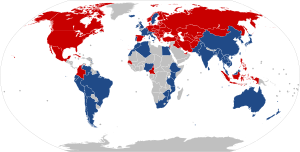
In most countries, rail traffic travels on the same side as road traffic. However, in many cases, railways were built using LHT British technology and, while road traffic switched to RHT, rail remained LHT. Examples include: Argentina, Belgium, Bolivia, Cambodia, Chile, Egypt, France, Iraq, Israel, Italy, Laos, Monaco, Myanmar, Nigeria, Peru, Portugal, Senegal, Slovenia, Sweden, Switzerland, Taiwan, Tunisia, Venezuela, and Yemen. In Indonesia it is the reverse (RHT for rails (even for LRT systems) and LHT for roads). France is mainly LHT for trains, except for the classic lines in Alsace-Lorraine,[87] which belonged to Germany from 1870 to 1918, when the railways were built, along with most metro systems. China is basically LHT for long-distance trains and RHT for metro systems. Spain, which is RHT for railways has LHT for metros in Madrid and Bilbao. Metros and light rail sides of operation vary, and might not match railways or roads in their country. Trams generally operate at the same side as other road traffic because they frequently share roads.
Boat traffic

Boats are traditionally piloted from starboard to facilitate priority to the right. According to the International Regulations for Preventing Collisions at Sea, water traffic is effectively RHT: a vessel proceeding along a narrow channel must keep to starboard (the right-hand side), and when two power-driven vessels are meeting head-on both must alter course to starboard also. For aircraft the US Federal Aviation Regulations suggest RHT principles, both in the air and on water, and in aircraft with side-by-side cockpit seating, the pilot-in-command (or more senior flight officer) traditionally occupies the left seat.[88]
Worldwide distribution by country
Of the 195 countries currently recognised by the United Nations, 141 use RHT and 54 use LHT on roads in general. A country and its territories and dependencies are counted as one. Whichever directionality is listed first is the type that is used in general in the traffic category.
| Country | Road traffic | Date of switch |
Notes, exceptions | |
|---|---|---|---|---|
| RHT | ||||
| RHT[89] | ||||
| RHT[90] | French Algeria until 1962. | |||
| RHT[91] | Landlocked between France and Spain. | |||
| RHT[92] | 1928 | Portuguese colony until 1975. | ||
| LHT[93] | This Caribbean island was a British colony until 1958. | |||
| RHT | June 10, 1945 | The anniversary on 10 June is still observed each year as Día de la Seguridad Vial (road safety day).[94] | ||
| RHT[95] | ||||
| LHT | British colonies before 1901. Continent is one nation. Includes Norfolk Island. | |||
| RHT | 1921–38 | Originally LHT, like most of Austria-Hungary, but switched sides during the Second World War. | ||
| RHT | ||||
| LHT[64] | British colony before 1973. Caribbean island. Most passenger vehicles are LHD.[39] | |||
| RHT | November 1967 | Former British protectorate. Switched to the same side as its neighbours.[96] | ||
| LHT | Part of British India before 1947. | |||
| LHT | This Caribbean archipelagic state was a British colony before 1966. | |||
| RHT[97] | ||||
| RHT | 1899[98] | |||
| RHT | 1961[1] | Former British colony. Switched to same side as neighbours. | ||
| RHT | Part of French West Africa before 1960. | |||
| LHT | Under British protection before 1949. | |||
| RHT | ||||
| RHT | 1918 | Switched sides after the collapse of Austria-Hungary. | ||
| LHT | British colony before 1966. | |||
| RHT | 1928 | Portuguese colony before 1822. | ||
| LHT | British protection until 1984. | |||
| RHT | ||||
| RHT | Part of French West Africa before 1958. | |||
| RHT | Belgian colony before 1962. | |||
| RHT | French colony before 1953. | |||
| RHT | 1961 | |||
| RHT | ||||
| 1920–1923 | ||||
| 1922 | ||||
| 1947 | Was a British Dominion until 1949. | |||
| 1923 | ||||
| 1924 | ||||
| RHT | 1928 | Portuguese colony before 1975. | ||
| RHT | French colonies before 1960. | |||
| RHT | ||||
| RHT | 1920s | |||
| Mainland | RHT | 1946 | Right-hand drive cars cannot be registered or used, except for those belonging to an embassy or consulate.[99] | |
| LHT | Hong Kong was under British rule from 1841 to 1941 and from 1945 to 1997, when the territory was handed back to China. | |||
| LHT | Macau was under Portuguese rule until 1999. | |||
| RHT | ||||
| RHT | French colony before 1975. | |||
| RHT | French colony before 1960. | |||
| RHT | Belgian colony before 1960. | |||
| RHT | ||||
(Côte d'Ivoire) |
RHT | Part of French West Africa before 1960. | ||
| RHT | 1926 | Was then part of the Kingdom of Serbs, Croats and Slovenes. | ||
| RHT | ||||
| LHT | Under UK administration before 1960. Island nation. De facto divided between the Republic of Cyprus, the Turkish Republic of Northern Cyprus, the UN buffer zone and the British base areas of Akrotiri and Dhekelia. All are LHT. | |||
| RHT | 1939 | Switched during the German occupation of Czechoslovakia. | ||
| RHT | Includes the Faroe Islands and Greenland. | |||
| RHT | French colony before 1977. | |||
| LHT | British colony before 1978. Caribbean island. | |||
| RHT | ||||
| LHT | 1976 | Portuguese colony until 1975. Switched to RHT with Portugal in 1928; under the Indonesian annexation, it was switched back to LHT in 1976. Its LHT status remains to this day. | ||
| RHT | ||||
| RHT | ||||
| RHT | ||||
| RHT | ||||
| RHT | 1964 | Italian colony before 1942. | ||
| RHT | ||||
| LHT | British colony until 1968. Continues to drive on the same side as neighboring countries. | |||
| RHT | 1964 | |||
| LHT | The island nation was a British colony before 1970. | |||
| RHT | June 8, 1858 | |||
| RHT | 1792 | Includes French Polynesia, New Caledonia, Saint Pierre and Miquelon, Wallis and Futuna, French Guiana, Réunion, Saint Barthélemy, the Collectivity of Saint Martin, Guadeloupe, and Mayotte. | ||
| RHT | French colony before 1960. | |||
| RHT | October 1, 1965 | British colony until 1965. Switched to RHT on 1 October 1965 being surrounded by the neighbouring former French colony of Senegal.[100] | ||
| RHT | About 40% of vehicles in Georgia are RHD due to the low cost of used cars imported from Japan.[101] | |||
| RHT[102] | ||||
| RHT | August 4, 1974 | British colony until 1957. Ghana switched to RHT in 1974,[103][104] a Twi language slogan was "Nifa, Nifa Enan" or "Right, Right, Fourth".[105] Ghana has also banned RHD vehicles - it prohibited new registrations of RHD vehicles after 1 August 1974, three days before the traffic change. | ||
| RHT | ||||
| LHT | British colony before 1974. Caribbean island. | |||
| RHT | ||||
| RHT | ||||
| RHT | 1928 | Portuguese colony until 1974. Drives on the same side as its neighbors. | ||
| LHT | British colony until 1970. One of the only two countries in continental America which are in LHT, the other being Suriname. | |||
| RHT | French colony until 1804. | |||
| RHT | ||||
| RHT | 1941 | Originally LHT, like most of Austria-Hungary, but switched sides during the Second World War. | ||
| RHT | May 26, 1968 | Changed from LHT on H-dagurinn. Most passenger cars were already LHD. | ||
| LHT | Part of British India before 1947. | |||
| LHT[106] | Roads and railways were built by the Dutch, with LHT for roads to conform to British and Japanese standards and RHT for railways to conform with Dutch standards. The Jakarta MRT and Palembang LRT also use RHT. Did not change sides, unlike the Netherlands, in 1906. | |||
| RHT | ||||
| RHT | ||||
| LHT | Part of the United Kingdom before 1922. An island nation with a land border with the United Kingdom, which is also LHT. | |||
| RHT | ||||
| RHT | 1924–26 | |||
| LHT | British colony before 1962. Caribbean island. | |||
| LHT[107] | LHT enacted in law in 1924. One of the few non-British-colony countries to use LHT. Okinawa was RHT from June 24, 1945 to July 30, 1978. | |||
| RHT | ||||
| RHT | ||||
| LHT[108] | Part of the British East Africa Protectorate before 1963. | |||
| LHT | UK colony before 1979. Pacific islands. | |||
| RHT | ||||
| RHT | British Protectorate until 1961. | |||
| RHT | In 2012, over 20,000 cheap used RHD cars were imported from Japan.[109] | |||
| RHT | French colony until 1947. The Thai-Lao Friendship Bridge is LHT. | |||
| RHT | ||||
| RHT | French Mandate of Lebanon before 1946. | |||
| LHT | Enclave of LHT South Africa. | |||
| RHT | ||||
| RHT | Italian Libya colony from 1911 to 1947. | |||
| RHT | Landlocked between Switzerland and Austria. | |||
| RHT | ||||
| RHT | ||||
| RHT | Former French colony. | |||
| LHT | British colony before 1964. | |||
| LHT | British colony before 1957. | |||
| LHT | This island nation was a British colony before 1965. | |||
| RHT | Part of French West Africa before 1960. | |||
| LHT | British colony before 1964. | |||
| RHT | Was under American control. | |||
| RHT | Part of French West Africa before 1960. Mining roads between Fderîck and Zouérat are LHT.[110] | |||
| LHT | This island nation was a British colony before 1968. | |||
| RHT | ||||
| RHT | Was under American control. | |||
| RHT | ||||
| RHT | Was under French control. | |||
| RHT | ||||
| RHT | ||||
| RHT | Former French colony. | |||
| LHT | Portuguese colony until 1975. | |||
| RHT | 1970 | Part of British India until 1948. Switched to RHT in 1970. Most passenger vehicles are RHD. | ||
| LHT | 1918 | When South Africa occupied German South West Africa in 1920, it switched to LHT. Administered by South Africa 1920–1990. | ||
| LHT | 1918 | This island nation was administered by Australia, New Zealand and the United Kingdom until 1968. | ||
| LHT | Shares land border with LHT India. | |||
| RHT | 1906[111] | Includes Curaçao, Sint Maarten, and Aruba | ||
| LHT[112] | These Pacific islands, including territories Niue and Cook Islands, were former British colonies. | |||
| RHT | ||||
| RHT | Part of French West Africa before 1958. | |||
| RHT | 1972 | British colony until 1960. Switched to RHT due to being surrounded by RHT former French colonies. | ||
| RHT | 1946 | Was LHT during the period of Japanese rule. Switched to RHT after the Surrender of Japan. | ||
| RHT | ||||
| RHT | ||||
| RHT[113] | ||||
| LHT | Part of British India before 1947. | |||
| RHT | Most passenger vehicles are RHD. | |||
| RHT | ||||
| RHT | 1943 | |||
| LHT | After Australia occupied German New Guinea during World War I, it switched to LHT. | |||
| RHT | 1945 | |||
| RHT | ||||
| RHT | 1946[52] | Was LHT during the Spanish and American colonial periods. Switched to RHT during the Battle of Manila in 1945. Philippine National Railways switched to RHT in 2010. | ||
| RHT | ||||
| RHT[106] | 1928 | Colonies Goa, Macau and Mozambique, which had land borders with LHT countries, did not switch and continue to drive on the left.[114] The Porto Metro uses RHT. | ||
| RHT | Former British protectorate. Switched to same side as neighbours. | |||
| RHT | 1919 | Parts of Romania that formerly belonged to Austria-Hungary (Transylvania, Bukovina, parts of the Banat, Crișana and Maramureș) were LHT until 1919. | ||
| RHT | In the Russian Far East RHD vehicles are common due to the import of used cars from nearby Japan.[115] Railway between Moscow and Ryazan, Sormovskaya line in Nizhny Novgorod Metro and Moskva River cable car use LHT. | |||
| RHT[65] | ||||
| LHT | This Caribbean island nation was a British colony before 1967. | |||
| LHT | These Caribbean island nations were British colonies before 1979. | |||
| LHT | ||||
| LHT | September 7, 2009 | Switched to LHT for economical reasons: to allow cheaper importation of cars from Australia, New Zealand and Japan.[106] | ||
| RHT | Enclaved state surrounded by Italy. | |||
| RHT | 1928 | Portuguese colony until 1975. | ||
| RHT | 1942 | |||
| RHT | Part of French West Africa before 1960. | |||
| RHT | 1926 | (as part of Kingdom of Serbs, Croats and Slovenes), Vojvodina was LHT while part of Austria-Hungary. | ||
| LHT | This island nation was a British colony until 1976. | |||
| RHT | March 1, 1971[116] | British colony until 1961. Switched to RHT being surrounded by neighbouring former French colonies. Furthermore, it banned the importation of RHD vehicles in 2013.[117] | ||
| LHT | This island nation was a British colony until 1963. It was also part of Malaysia until 1965. | |||
| RHT | 1939–41 | Switched during the German occupation of Czechoslovakia. | ||
| RHT | 1926 | (as part of Kingdom of Serbs, Croats and Slovenes), officially LHT from 1915 as part of Austria-Hungary. | ||
| LHT | This island nation was a British colony before 1975. | |||
| RHT | The former British Somaliland had LHT until it formed a union with the former Italian Somaliland which had RHT. | |||
| LHT[118][119] | British colony before 1909. | |||
| RHT | 1946 | Was LHT during the period of Japanese rule. Switched to RHT after the Surrender of Japan. | ||
| RHT | 1973 | Part of Sudan until 2011. | ||
| RHT | 1924 | Up to the 1920s Barcelona was RHT, and Madrid was LHT until 1924. The Madrid Metro still uses LHT. | ||
| LHT | Part of British Ceylon from 1815 to 1948. | |||
| RHT | 1973 | Formerly Anglo-Egyptian Sudan, it switched sides 17 years later to match neighbors. | ||
| LHT | 1920s | Dutch colony until 1975. One of the only two countries in continental America which are in LHT, the other being Guyana. | ||
| RHT | September 3, 1967 | The day of the switch was known as Dagen H. Most passenger vehicles were already LHD. | ||
| RHT | ||||
| RHT | Was under French and Italian control. | |||
| RHT | 1946 | Was LHT during the period of Japanese rule. The government of the Republic of China changed Taiwan to RHT in 1946 along with the rest of China.[120] | ||
| RHT | ||||
| LHT | Part of the British East Africa Protectorate until 1961. | |||
| LHT[106] | One of the few non-British-colony LHT countries. Shares a long land border with RHT Myanmar, Laos and Cambodia. | |||
| RHT | Part of French West Africa until 1960. | |||
| LHT | British protectorate before 1970. Polynesian island nation. | |||
| LHT[121] | British colony before 1962. Caribbean island. | |||
| RHT | RHT was enforced in the French protectorate of Tunisia since 1881. | |||
| RHT | 1926 | |||
| RHT | ||||
| LHT | Formerly a British colony. Became independent in 1978. | |||
| LHT | Part of British Uganda Protectorate from 1894 until 1962. | |||
| RHT | 1922[13] | |||
| RHT | Former British protectorate. Switched to same side as neighbours. | |||
| Mainland | LHT | An island nation with a land border with the Republic of Ireland, which is also LHT. Also LHT are the Crown dependencies of the Isle of Man, and the British Overseas Territories of Anguilla, Ascension Island, Bermuda, Montserrat, Pitcairn Islands (unregistered), Saint Helena, and Tristan da Cunha. | ||
| RHT | ||||
| LHT | Most passenger vehicles are LHD.[40] | |||
| LHT | Most passenger vehicles are LHD. | |||
| LHT | Briefly switched to RHT during the Falklands War. | |||
| RHT | 1929 | Gibraltar is RHT because of its land border with Spain.[122] | ||
| LHT | Was RHT from 1940 to 1945 due to the German occupation.[123] | |||
| LHT | Was RHT from 1940 to 1945 due to the German occupation.[123] | |||
| LHT | Most passenger vehicles are LHD.[42] | |||
| Mainland | RHT | |||
| LHT | U.S. Virgin Islands, like much of the Caribbean, is LHT and is the only American jurisdiction that still has LHT, because the islands drove on the left when the US purchased the former Danish West Indies in the 1917 Treaty of the Danish West Indies. Most passenger vehicles are LHD. | |||
| RHT | September 2, 1945 | Became LHT in 1918, but as in some other countries in South America, changed to RHT in 1945.[124] A speed limit of 30 km/h (19 mph) was observed until 30 September for safety. | ||
| RHT | ||||
| RHT[125] | Co-administrated under France and United Kingdom until 1980. | |||
| RHT | Enclave of Rome. | |||
| RHT | ||||
| RHT | French colony until 1945. The Long Bien Bridge uses LHT. | |||
| RHT | Spanish colony until the late 1900s. | |||
| RHT | 1977[1] | South Yemen, formerly the British colony of Aden, changed to RHT in 1977. A series of postage stamps commemorating the event was issued.[126] At that time, North Yemen was already RHT. | ||
| LHT | British colony before 1964. | |||
| LHT | British colony before 1965. | |||
Gallery
.jpg) Right-hand traffic on the A2 in Germany
Right-hand traffic on the A2 in Germany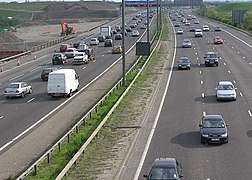 Left-hand traffic on the M25 motorway in the UK
Left-hand traffic on the M25 motorway in the UK Hong Kong drives on the left.
Hong Kong drives on the left.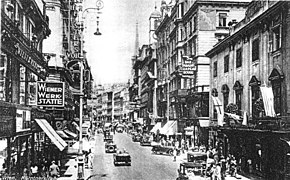 Left-hand traffic in Vienna, Austria circa 1930.
Left-hand traffic in Vienna, Austria circa 1930.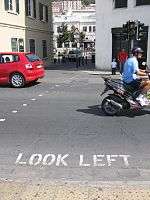 Gibraltar has been RHT since 1929.
Gibraltar has been RHT since 1929. Sign reminding motorists to drive on the left in Ireland.
Sign reminding motorists to drive on the left in Ireland.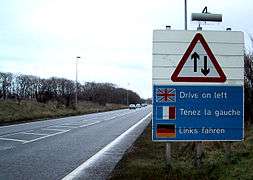 A road sign in the British county of Kent placed on the right-hand side of the road.
A road sign in the British county of Kent placed on the right-hand side of the road. Change of traffic directions at the Thai–Lao Friendship Bridge
Change of traffic directions at the Thai–Lao Friendship Bridge
See also
References
- Kincaid, Peter (December 1986). The Rule of the Road: An International Guide to History and Practice. Greenwood Press. pp. 50, 86–88, 99–100, 121–122, 198–202. ISBN 978-0-313-25249-5.
- "Worldwide Driving Orientation by Country". Retrieved 13 December 2016.
- Barta, Patrick. "Shifting the Right of Way to the Left Leaves Some Samoans Feeling Wronged". The Wall Street Journal. Retrieved 4 December 2016.(subscription required)
- Watson, Ian. "The rule of the road, 1919–1986: A case study of standards change" (PDF). Retrieved 30 November 2016.
- McManus, Chris (2002). Right Hand Left Hand: the origins of asymmetry in brains, bodies, atoms, and cultures. Cambridge, Massachusetts: Harvard University Press. p. 247. ISBN 0-674-00953-3. Retrieved 5 November 2019.
- Searing, Linda. "The Big Number: Lefties make up about 10 percent of the world". Washington Post. Retrieved 27 November 2019.
- Latham, Mark (18 December 2009). The London Bridge Improvement Act of 1756: A Study of Early Modern Urban Finance and Administration (PhD). University of Leicester.
- The Statutes at Large from the 26th to the 30th Year of King George III. Printed by J. Bentham. 1766.
- Hamer, Mike (25 December 1987 – 1 January 1987). "Left is right on the road". New Scientist (20 December 1986/1 January 1987): 16–18. Retrieved 7 October 2016.
- Planta, Edward (30 June 1831). "A New Picture of Paris, Or, The Stranger's Guide to the French Metropolis: Also, a Description of the Environs of Paris". S. Leigh and Baldwin and Cradock – via Google Books.
- "De geschiedenis van het linksrijden". Engelfriet.net. Retrieved 14 May 2014.
- "1938 wechselte man nicht nur die Straßenseite – ARGUS Steiermark – DIE RADLOBBY". graz.radln.net. Retrieved 4 April 2019.
- "Krakowska Komunikacja Miejska – autobusy, tramwaje i krakowskie inwestycje drogowe – History of the Cracow tram network". Komunikacja.krakow.eurocity.pl. 28 November 1982. Archived from the original on 19 August 2011. Retrieved 11 May 2009.
- Baedeker, Karl (1900). "Austria, including Hungary, Transylvania, Dalmatia and Bosnia". p. xiii–xiv. Retrieved 28 July 2017.
In Styria, Upper and Lower Austria, Salzburg, Carniola, Croatia, and Hungary we keep to the left, and pass to the right in overtaking; in Carinthia, Tyrol, and the Austrian Littoral (Adriatic coast: Trieste, Gorizia and Gradisca, Istria and Dalmatia) we keep to the right and overtake to the left. Troops on the march always keep to the right side of the road, so in whatever part of the Empire you meet them, keep to the left.
- Vasold, Manfred (2010). "Obacht! Linksverkehr" (PDF). Kultur & Technik. Retrieved 13 December 2016.
- "Seventy-five years of driving on the right". Radio Prague. 18 March 2014.
- Biocca, Dario (24 July 2011). "Quando l' Italia si buttò a destra". la Repubblica (in Italian). Retrieved 4 November 2019.
- "Högertrafik i Sverige och Finland". aland.net.
- "Högertrafik" (in Swedish). vardo.aland.fi. Archived from the original on 3 December 2007. Retrieved 11 August 2006.
- Réalités, Issues 200–205, Société d'études et publications économiques, 1967, page 95
- "This Day in History: Swedish Traffic Switches Sides – September 3, 1967". 3 September 2014. Retrieved 21 October 2019.
- "Sweden: Switch to the Right". Time. 15 September 1967. Archived from the original on 18 October 2012. Retrieved 31 October 2012.
- Mieszkowski, Katharine (14 August 2009). "Salon News: Whose side of the road are you on?". Salon. Retrieved 12 December 2010.
- 45 ár frá hægri umferð, Morgunblaðið, 26 May 2013 English translation
- Tom Geoghegan (7 September 2009). "Could the UK drive on the right?". BBC News Magazine. BBC. Retrieved 4 July 2012.
- "Layout of Grade Separated Junctions" (PDF). Design Manual for Roads and Bridges. The Highways Agency: 4.9ff. 2006. Archived from the original (PDF) on 4 May 2011.
- Tourist and Business Directory – The Gambia, 1969, page 19
- "LAWS OF SOUTH SUDAN, ROAD TRAFFIC AND SAFETY BILL, 2012" (PDF).
- Why We Drive on the Right of the Road, Popular Science Monthly, Vol.126, No.1, (January 1935), p.37. Bonnier Corporation. January 1935. Retrieved 25 April 2012.
- Weingroff, Richard. "On The Right Side of the Road". United States Department of Transportation. Retrieved 10 January 2014.
- "An Act Establishing the Law of the Road". Massachusetts General Court. Retrieved 14 February 2014.
- "Travel Tips | US Virgin Islands". Usvitourism.vi. Retrieved 25 April 2012.
- "The day New Brunswick switched to driving on the right". CBC. Retrieved 11 April 2019.
- "Change of Rule of Road in British Columbia 1920" (PDF). The British Columbia Road Runner. March 1966. Retrieved 27 August 2017.
- Griffin, Kevin (1 January 2016). "Week in History: Switching from the left was the right thing to do". The Vancouver Sun. Retrieved 26 August 2017.
- Smith, Ivan. "Highway Driving Rule Changes Sides". History of Automobiles – The Early Days in Nova Scotia, 1899–1949. Archived from the original on 8 August 2018. Retrieved 27 August 2017.
- Snyder, Timothy; Rowe, F.W. "Newfoundland Bill". The Canadian Encyclopedia. Retrieved 30 July 2019.
- Dyer, Gwynne (30 August 2009). "A triumph for left over right". Winnipeg Free Press. Retrieved 27 August 2017.
- Dive the Bahamas: Complete Guide to Diving and Snorkelling, Lawson Wood, Interlink Publishing Group, 2007, page 23
- U. S. and British Virgin Islands 2006, Fodor's Travel Publications, 2005, page 28
- Adventure Guide to the Cayman Islands, Paris Permenter, John Bigley, Hunter Publishing, Inc, 2001, page 46
- Turks and Caicos, Bradt Travel Guides, Annalisa Rellie, Tricia Hayne, 2008, page 50
- "The Unique World of Burmese Driving". a minor diversion. 14 March 2012. Retrieved 28 September 2015.
- Myanmar’s car market set to take new direction, Motokazu Matsui and Takemi Nakagawa, Financial Times, 2 January 2017
- L. R. Reddy (2002). Inside Afghanistan: End of the Taliban Era?. APH. ISBN 9788176483193. Retrieved 31 August 2015.
- Plaza Mayor de Manila, by José Honorato Lozano (1815/21(?)-1885), in the album Vistas de las islas Filipinas y trajes de sus habitantes, published 1847. Collection of the Biblioteca Nacional de España.
- "ESCOLTA MANILA PHILIPPINES- YEAR 1903". 6 March 2010. Retrieved 14 March 2017 – via YouTube.
- "Manila – Castillian Memoirs 1930s". 19 April 2008. Retrieved 14 March 2017 – via YouTube.
- "Manila, Queen of the Pacific 1938". 6 May 2008. Retrieved 14 March 2017 – via YouTube.
- Goupal, Lou (26 June 2013). "Manila Nostalgia: Dewey Boulevard during the Japanese occupation". Manila Nostalgia. Retrieved 14 March 2017 – via YouTube.
Original video clips from a Japanese propaganda film shot in early 1942.
- Tadeo, Patrick Everett (10 March 2015). "How the Philippines became a left-hand-drive country". Top Gear Philippines. Retrieved 14 March 2017.
- "Executive Order No. 34, s. 1945". officialgazzete.gov.ph.
- Andrew H. Malcolm (5 July 1978). "U-Turn for Okinawa: From Right-Hand Driving to Left; Extra Policemen Assigned". The New York Times. p. A2.
- "Cambodia bans right-hand drive cars". BBC News. 1 January 2001. Retrieved 12 January 2007.
- Bryant, Nick (7 September 2009). "Samoan cars ready to switch sides". BBC News. Retrieved 7 September 2009.
- Askin, Pauline (7 September 2009). "Outcry as Samoa motorists prepare to drive on left". Reuters. Retrieved 7 September 2009.
- Whitley, David (3 July 2009). "Samoa provokes fury by switching sides of the road". The Telegraph. Retrieved 12 September 2019.
- Dobie, Michael (6 September 2009). "Samoa drivers brace for left turn". BBC News. Retrieved 7 September 2009.
- "Samoan drivers change from right-hand side of the road to the left". Herald Sun. Retrieved 31 October 2012.
- Jackson, Cherelle (25 July 2008). "Samoa announces driving switch date". The New Zealand Herald. Retrieved 10 June 2012.
- "Decreto nº 18.323, de 24 de Julho de 1928". Cãmara dos Deputados. Retrieved 11 April 2019.
- Panama Shifts To Right Handed Driving Of Cars, Chicago Tribune, 25 April 1943
- De izquierda a derecha, ABC Color, 2 March 2014
- "Compilation of Foreign Motor Vehicle Import Requirements" (PDF). United States Department of Commerce International Trade Administration Office of Transportation and Machinery. December 2015. Retrieved 9 April 2019.
- Nkwame, Marc (27 July 2013). "Burundi, Rwanda to start driving on the left". DailyNews Online. Retrieved 28 May 2016.
- Peter. "Rwanda to adopt EAC driving standards". Rwanda Transport. Retrieved 12 August 2013.
- "Rwanda wants to drive on the left". Independent.co.ug. 3 June 2012. Retrieved 10 June 2012.
- "East Africa: Rwanda Looks to the Left". allAfrica.com. 27 September 2010. Retrieved 10 June 2012.
- Bari, Dr Mahabubul (29 July 2014). "The study of the possibility of switching driving side in Rwanda". European Transport Research Review. 6 (4): 439–453. doi:10.1007/s12544-014-0144-2.
- Right-hand-drive vehicles return on Rwandan roads, The East African, 13 March 2015
- Tumwebaze, Peterson (9 September 2014). "Govt okays importation of RHD trucks, to decide on other vehicle categories in October". The New Times. Retrieved 29 October 2014.
- Jennings, Ken. "What Happens When Left-Hand Roads Meet Right-Hand Roads". Conde Nast Traveler. Retrieved 18 November 2016.
- "Hong Kong 2006 – Transport – Cross-Boundary Traffic". Government of Hong Kong. 15 August 2007. Retrieved 12 December 2010.
- "Takutu bridge opens to traffic". Stabroeknews.com. 27 April 2009. Retrieved 12 December 2010.
- "Left-hand drive definition and meaning | Collins English Dictionary". www.collinsdictionary.com. Retrieved 16 May 2020.
- "Nearside (dictionary definition)". Dictionary.reverso.net. Retrieved 12 December 2010.
- Unrau, Jason. "Why Is One Wiper Blade Longer Than the Other?". Your Mechanic. Retrieved 15 April 2019.
- Miller, Wayne (2015). Car Crazy: The Battle for Supremacy between Ford and Olds and the Dawn of the Automobile Age. PublicAffairs. p. 279. ISBN 9781610395526. Retrieved 12 December 2016.
- "天彩彩票_官网手机版". www.lhdspecialist.com. Archived from the original on 21 September 2011.
- Hinchliffe, Mark (11 March 2014). "How to mount your motorbike". Retrieved 11 December 2016.
- "MOUNTING AND DISMOUNTING A MOTORCYCLE". Motorcycle Test Tips. Retrieved 11 December 2016.
- "S.I. No. 5/2003 – Road Traffic (Construction and Use of Vehicles) Regulations 2003". Irish Statute Book. 42. (1). Retrieved 6 November 2017.
where a side–car is attached to a mechanically propelled bicycle, the side–car shall be ... fitted on the left side of the vehicle
; "Motorcycle Sidecar & Trailer legislation". MAG Ireland. Irish Motorcyclists Association. 9 February 2014. Retrieved 6 November 2017. - "The Road Vehicles (Construction and Use) Regulations 1986 – Section 93". UK Government. 25 June 1986. Retrieved 9 December 2012.
- "UN Regulation 112, "Motor vehicle headlamps emitting an asymmetrical passing beam or a driving beam or both and equipped with filament lamps"" (PDF). Retrieved 21 October 2019.
- "UN Regulation 48" (PDF). Retrieved 21 October 2019.
- "Popular family SUV Hyundai Tucson slammed for 'four-star' Australian crash test result". Retrieved 5 November 2017.
- "Strasbourg to Paris Driver's eye view PREVIEW". Video 125. Retrieved 11 March 2019 – via YouTube.
- FAR Sec. 91.115(c): "When aircraft, or an aircraft and a vessel, are approaching head-on, or nearly so, each shall alter its course to the right to keep well clear."
- "Driving Tips in Albania – Sixt rent a car". sixt.co.uk. Retrieved 3 April 2019.
- http://www.nyszone.com. "Driving in Algeria". adcidl.com. Retrieved 3 April 2019.
- Focus, Expat. "Andorra – Driving and Transportation | ExpatFocus.com". expatfocus.com. Retrieved 3 October 2019.
- "Driving Tips in Angola – Sixt rent a car". sixt.co.uk. Retrieved 3 April 2019.
- "Road Safety Guidelines For Visitors – Drive-a-Matic Car Rentals Antigua". antiguarentalcar.com. Retrieved 3 April 2019.
- "10 de Junio: Día Mundial de la Seguridad Vial". Retrieved 13 December 2016.
- Staff, Weekly (10 January 2018). "Armenian Government Plans to Ban Right-Hand Drive Vehicles; Drivers Protest Decision". The Armenian Weekly. Retrieved 3 April 2019.
- Bahrain Government Annual Reports. Times of India Press. 1968. p. 158.
- "Driving in Belarus". autoeurope. Retrieved 11 April 2019.
- "The history of left- and right-hand traffic". International Driving Authority. Retrieved 11 April 2019.
- Wang, Joey (3 April 2018). "Spotted In China: G50 Toyota Century V12 In Black, RHD". CarNewsChina.com.
- Tourist and Business Directory, The Gambia. 1969. p. 19.
- ""Выживут" ли праворульные машины в Грузии". sputnik-georgia.ru. Retrieved 26 June 2018.
- Hillger, Don; Toth, Garry. "Right-Hand/Left-Hand Driving Customs". Colorado State University. Retrieved 13 December 2016.
- "Right-Hand Traffic Act". Ghanalegal.com. Retrieved 14 May 2014.
- Daily Graphic (7526): 9. 21 December 1974 https://books.google.co.uk/books?id=UyCl5iWBSzwC&pg=PA5&dq=ghana%20drive%20right%201974#v=onepage&q=ghana%20drive%20right%201974. Missing or empty
|title=(help) - Phil Bartle. "Studies Among the Akan People of West Africa Community, Society, History, Culture; With Special Focus on the Kwawu by Phil Bartle, PhD". Cec.vcn.bc.ca. Retrieved 14 May 2014.
- "Right-Hand Traffic versus Left-Hand Traffic". The Basement Geographer. Archived from the original on 10 February 2017. Retrieved 22 November 2018.
- "Why Does Japan Drive on the Left". 2pass.co.uk. Retrieved 11 August 2006.
- "Customs Services Department – Frequently Asked Questions". KRA. Retrieved 12 December 2010.
- "Over 20,000 Right Hand Drive Cars Imported in Kyrgyzstan in 2012". The Gazette of Central Asia. Satrapia. 8 May 2013.
- "Photo of All Change. Swop Over Point for the Traffic !". Panoramio. Retrieved 10 June 2012.
- Peter van Ammelrooy. "De Claim links rijden". De Volkskrant (in Dutch). Retrieved 14 May 2014.
- "2.1 "Keeping Left" – Land Transport (Road User) Rule 2004 – New Zealand Legislation". New Zealand Government. Retrieved 28 November 2010.
- "Travel advice by country, Oman". Foreign & Commonwealth Office (fco.gov.uk). Archived from the original on 8 April 2008. Retrieved 8 August 2006.
- Mozambique: memoirs of a revolution, John Paul, Penguin, 1975, page 41
- "Russian Far East is still attached to Japanese cars". Russia behind the headlines. 31 August 2016. Retrieved 12 August 2017.
- The Rising Sun: A History of the All People's Congress Party of Sierra Leone. A.P.C. Secretariat. 1982. p. 396.
- de Vries, Nina (17 September 2013). "Sierra Leone Bans Right-Hand Vehicles as Hazards". Voice of America.
- "Road Rules". SACarRental.com. Archived from the original on 2 January 2013. Retrieved 15 February 2014.
- "Driving in South Africa Information". drivesouthafrica.co.za. Retrieved 15 February 2014.
- Passed by the Legislative Yuan (1946). "違警罰法 (Act Governing the Punishment of Police Offences)". Archived from the original on 10 December 2013. Retrieved 14 August 2012.
- O'Donnell, Kathleen; Pefkaros, Stassi (2000). Trinidad and Tobago Adventure Guide. Hunter Publishing, Inc. p. 53.
- Colonial Reports. Annual. 1480–1499. 1930. p. 76.
- King, Peter (1991). The Channel Islands War: 1940–1945. Hale. p. 31.
- El día en que el Río de la Plata dejó de manejar por la izquierda, Autoblog, 25 August 2015
- "RHD/LHD Country Guide". toyota-gib.com. Retrieved 22 September 2017.
- "South Yemen – Postage stamps – 1977". stampworld.com.
External links
![]()
- Google Maps placemarks of border crossings where traffic changes sides (browser-based), also available as a Google Earth placemarks file (requires Google Earth)
- The Extraordinary Street Railways of Asunción, Paraguay